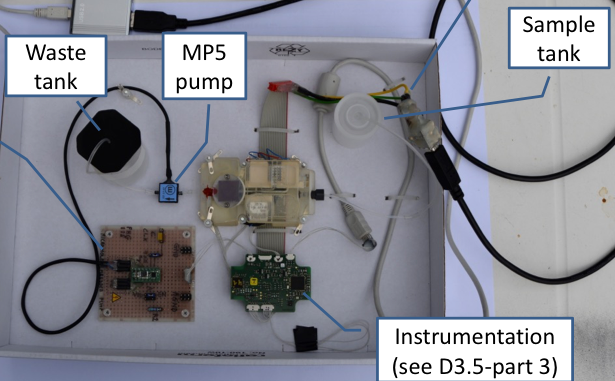Chemical Sensors and Specificity
Initial aim
The main objective of this work package is the design, development and testing of the electro-chemical sensors aimed to detect (meth)amphetamines or clear indicators of the production process thereof. A capacitive system equipped with disposable electrodes will be used. These electrodes will be functionalized with molecularly imprinted polymers (MIPs) as recognition elements. There are several main tasks considered in this project.
Significant results, Innovations and Achievements
The real innovations were:
- Synthesis of the different MIPs towards NFA, BMK and 4M5PP;
- The transducers with the 6 working electrodes applicable to multiplex sensing; these can be combined as multiplex MIP-based electrochemical detection
- The low-power miniaturized ASIC-based;
- The design and validation of two independent chemosensor prototypes (suitcase” and “cardboard”) which can be used for different multiplex environmental applications and the corresponding software to control the ASIC-based system readout.
MIP-based chemical sensor conclusions
The conclusion and lessons learnt for WP3:
- The matrix interference by sewage water on the chemical sensor performance was more extreme than originally estimated. The diversity of sewage water composition and the extreme conditions made data interpretation complex. A more extensive ‘library’ of different sewage compositions is needed as well as different scenarios how the sensor reacts should be kept in a database. The developed software for data interpretation and decision-making is still much too complex for easy on-site use.
- Despite the fact that the binding event between MIP and target happens in a few seconds, the time to get a stable baseline after chemical sensor regeneration is much too long for practical use. This might be inherent to the capacitive sensing principle.
- Concerning the integration (but this is WP7) of the chemical sensor in the Micromole ring system, all components are miniaturized and ready; only the main board needs to be resized to fit.
Publications
PUBLICATION: Sewage monitoring system for tracking synthetic drug laboratories – Download PDF
PUBLICATION1 – MICROCONTACT IMPRINTING BASED CAPACITIVE BIOSENSORS FOR REAL-TIME PROTEASE DETECTION/QUANTIFICATION -Download PDF
PUBLICATION2 – Characterisation of chemical waste from illegal amphetamine synthesis to support forensic assessment of clandestine drug laboratories – Download PDF
PUBLICATION3 – Design of synthetic receptors for monitoring of AMP-based Stimulants – Download DOC
PUBLICATION4 – Capacitive sensing of amphetaminetype stimulants based on immobilized molecular imprinted polymers – Download DOC
PUBLICATION5 – Design of synthetic receptors for monitoring of ATS-based stimulants – Dowload PPTX
PUBLICATION7 – Sewage monitoring system for tracking synthetic drug laboratories – Download PDF
